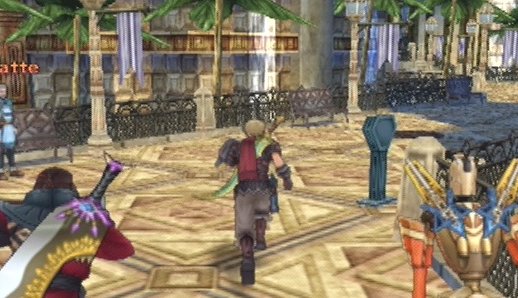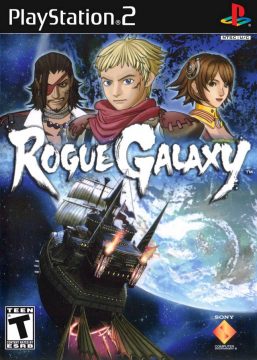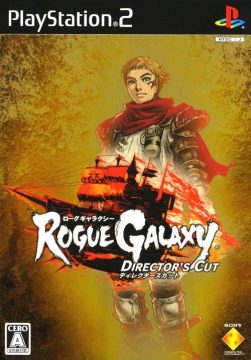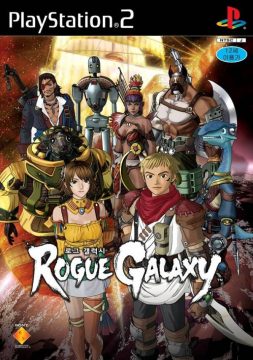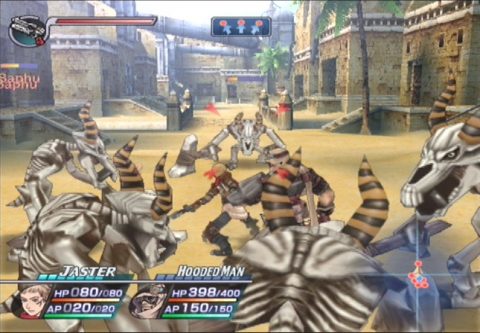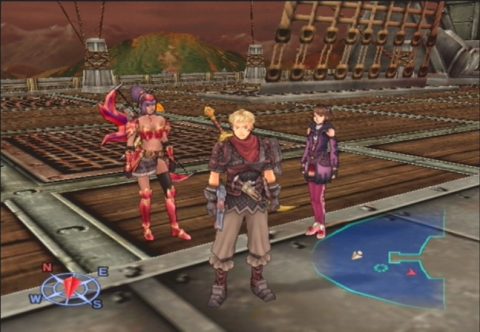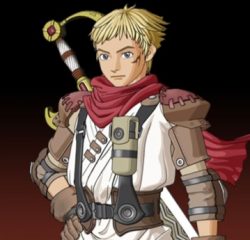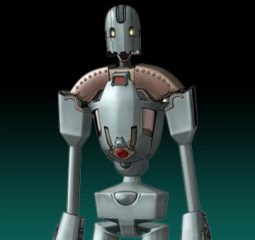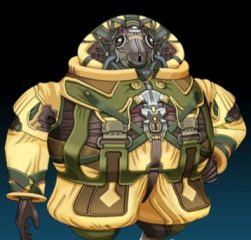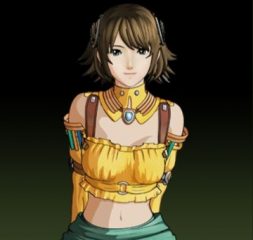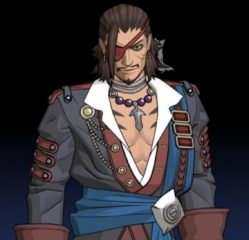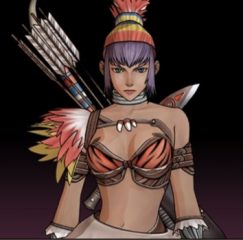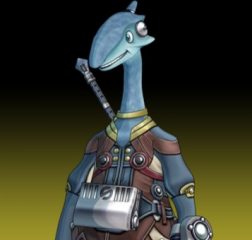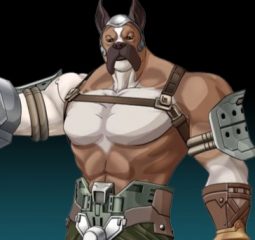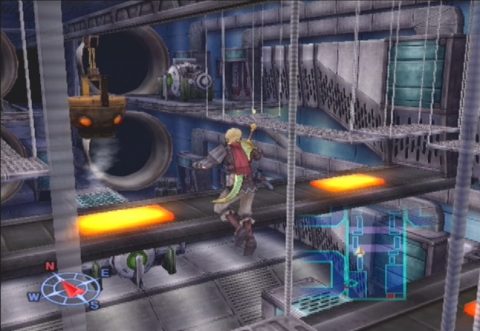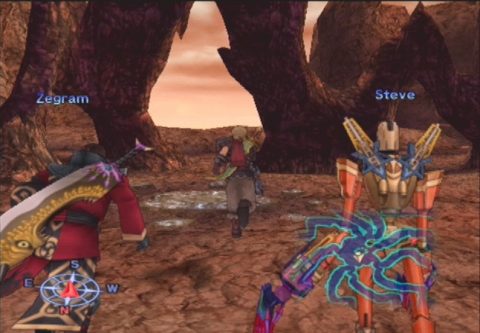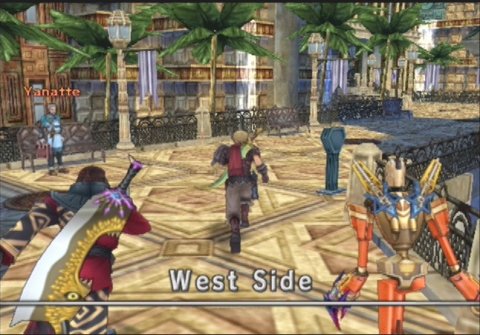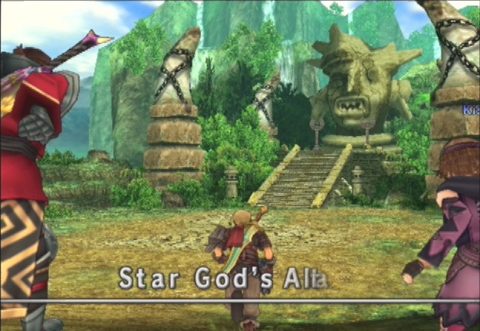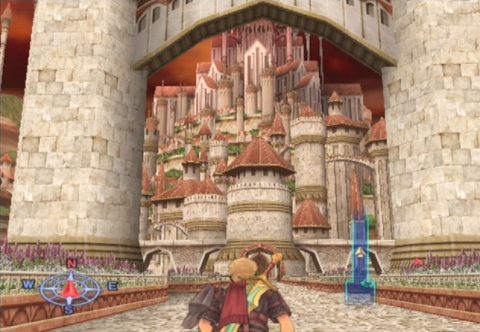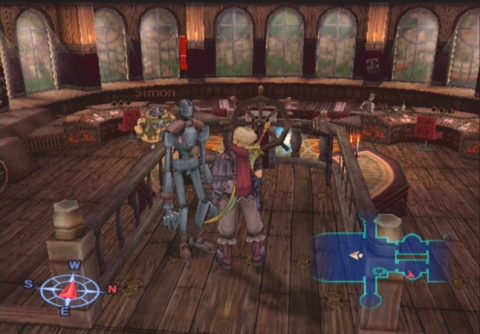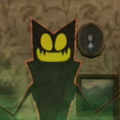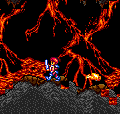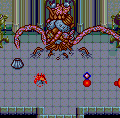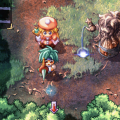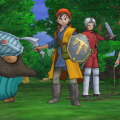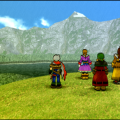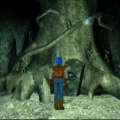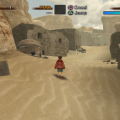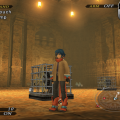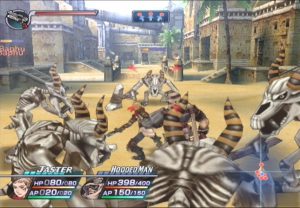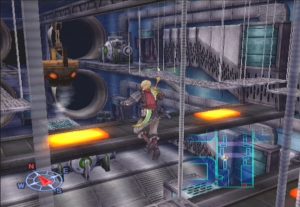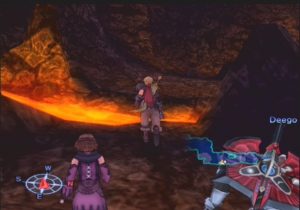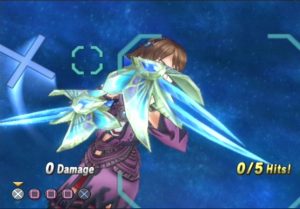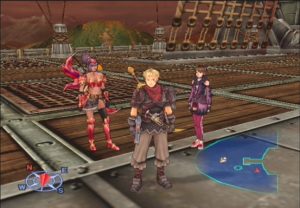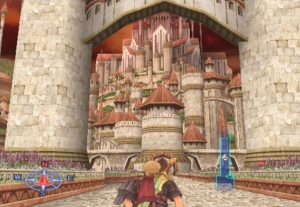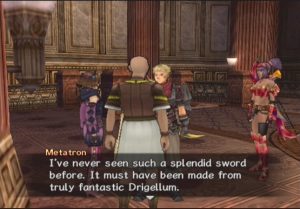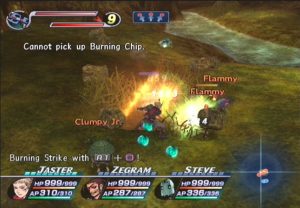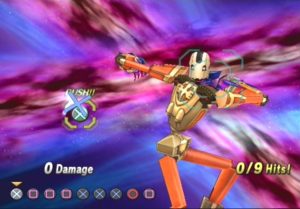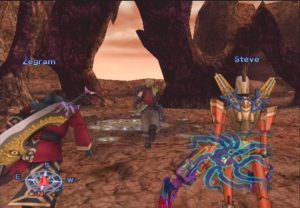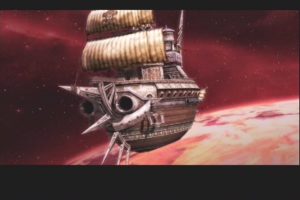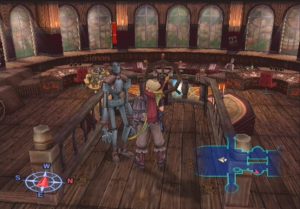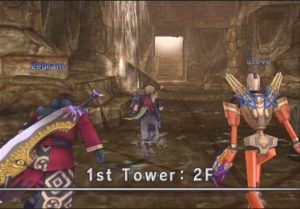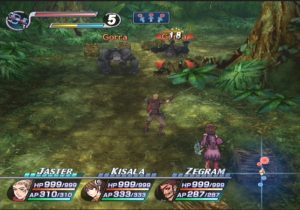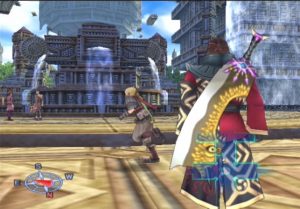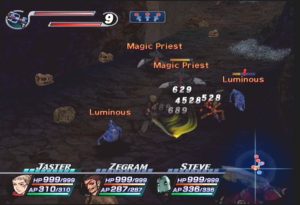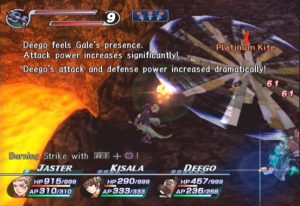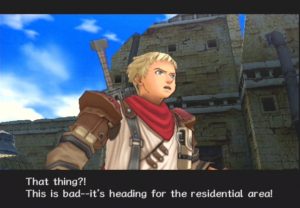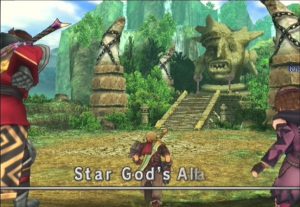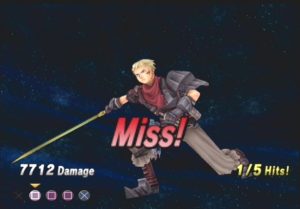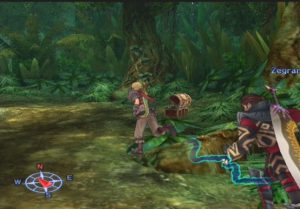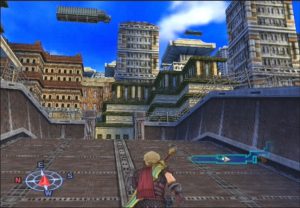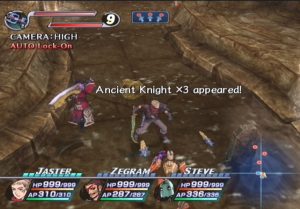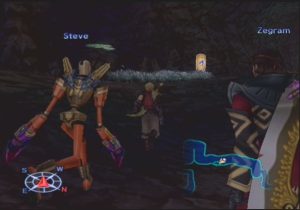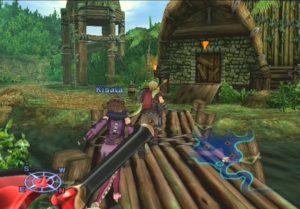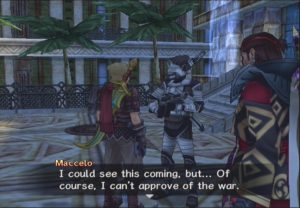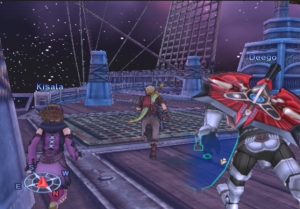JRPGs represent a rather large dilemma that has plagued both the people who make them and the people who play them for many years now: balance. The task of balancing a great story and a fun game is a very daunting one. It almost always seems that if a JRPG is lots of fun, that fun usually comes at the cost of narrative depth. Likewise, you’ll quite often find a direct, positive correlation between the quality of a JRPG’s plot and how boring the game is to play. That’s not to say this balancing act is impossible. A few legendary titles here and there have done a really good job and have presented an all around excellent experience. But more often than not, a compromise is made. This brings us to Rogue Galaxy, which is a pretty big compromise, and a prime example of this aforementioned loss of equilibrium. Fortunately, what it does right is so right that you can almost forget (or rather, forgive) the wrong.
Rogue Galaxy is the story of Jaster Rogue, a rugged young bounty hunter living on the remote desert planet of Rosa. Jaster has big dreams and ambitions to set out on a voyage that’ll take him beyond the stars, but his life is weighted down in mediocrity at the moment. Although Jaster, being a matured adult as opposed to a spunky young adolescent, is a bit of a breath of fresh air in terms of main characters, he’s definitely not getting any points for originality. He and the game he inhabits is full of stock characters and stock situations, most of them taken from Star Wars.
As one would expect from any adventure story, the monotony of Jaster’s life is flipped upside down upon a chance encounter with a pair of space pirates, Steve and Simon (whom function as his C3PO and R2D2, respectively). These two oddball swashbucklers are scouring the planet of Rosa (Tatooine) in search of a bounty hunter named Desert Claw (Obi-Wan Kenobi). They seek to enlist him as part of their crew, but upon encountering Jaster and his abilities as a bounty hunter, they mistakenly bring him into their group, assuming that he is the Desert Claw they seek. Jaster, seeing this as a prime opportunity to jumpstart his own quest, doesn’t tell them that he’s not the legendary bounty hunter and escapes Rosa and to set out into the sea of stars he’s always dreamed of exploring.
And thus the saga of Jaster Rogue begins. Throughout his adventures, he will meet a cast of colorful and memorable characters, each with their own well-developed back stories that will slowly be exposed over the course of the game. No character is insignificant, and each one of Jaster’s companions has some kind of revelation that will change your entire outlook on them.
What really helps the characters along is one of the most incredibly well-done voice overs I’ve ever heard in a game. Where I’ve found myself cringing during most RPGs that have spoken dialog, Rogue Galaxy has some veteran anime/TV show actors giving sincere and fitting performances, notably Steve Blum, whom many will recognize from his numerous anime and video game roles.
Characters
Jaster
As mentioned above, Jaster is a nice break from the plucky, young, fanatically altruistic teenies that usually spearhead Japanese adventures. He’s more level-headed and easygoing. At the same time, he doesn’t have terribly much personality either. In battle, he uses swords as his primary weapons and pistols as his secondary weapons. Having Jaster in your battle party isn’t necessary, but it’s suggested since a lot of enemies set up barriers that can only be removed with Jaster’s guns. Jaster also has a gun that creates platforms in mid air, also required to pass certain dungeons.
Steve
Steve is robot created by the head scientist at the ship factory on Zerard. Steve is worrisome, but very caring and compassionate. However, there is a hidden, unpredictable element to his programming that is slowly revealed during the course of the game. Steve uses a combination of claws and laser-firing bits, and most of his attacks involve electricity.
Simon
Simon is a squat, fat man who hides himself inside a space suit. Like most of the characters in the game, he hides a dark secret. For some unknown reason, Simon abandoned his wife and daughter to travel with Dorgengoa, the pirate. Simon uses area-affecting spray guns and rocket launchers in combat.
Kisala
Kisala is Dorgengoa’s daughter. He is very protective of her, though she’s quite capable of taking care of herself. She’s very feisty and spirited, defying a lot of the conventions her type of character would normally have in an RPG. Much like Jessica in Level-5’s previous RPG, Dragon Quest VIII, Kisala has lots of outfits that take advantage of her assets. In battle, Kisala is a stalwart character, utilizing great speed, fast combos and potent magic. Her only drawback is that she uses daggers and kick-boxing, lacking any ranged attacks outside of magic.
Zegram
If Jaster is Luke Skywalker, Zegram is definitely Han Solo. A fellow bounty hunter working for Dorgengoa, Zegram is initially cold and unresponsive to the rest of the group. He maintains a cynical edge and general lack of trust throughout the game, though it’s later revealed that he has reasons for not getting close to anyone. In battle, Zegram is a well balanced character and functions similarly to Jaster, using swords and shuriken as his weapons.
Lilika
Lilika is a beautiful maiden from the jungle planet of Juraika. She is very ferocious and lacks trust for outsiders visiting her planet. She is constantly at odds with the elders in her village and their more traditional values. In battle, Lilika uses bows and daggers in combat and has some very powerful magic.
Jupis
Jupis is a very odd character. Fired from his job at the space ship factory on Zerard, Jupis attempts to destroy it by taking control of the factory’s robots. Jaster and company are tasked with stopping him, after which, Jupis decides to join the party. Jupis doesn’t have much character development, but he’s a pretty neat character to have around considering all his quirks and his wonderful prowess in combat, where he uses a combination of spears and disc-like homing weapons.
Deego
Deego is a war veteran who hangs out in the seedy underbelly of Myna on Vedan, a planet cloaked in eternal night, and a haven for less than savory types. Deego is caught up in a complex, triangular relationship with Angela, the beautiful owner of the bar Deego calls home, and Gale, his friend and comrade during the war. In battle, Deego is a tank, using axes and his arm-mounted gatling guns to crush his enemies.
Alas, as charming as the characters in Rogue Galaxy are, even they can’t drive the story along. Things start out interestingly enough, but the game’s story loses steam quickly and never really gains it back. Each situation gets more convoluted and downright silly than the last, and a lot of the story arcs seem to end prematurely and vaguely, with lots of questions left unanswered and loose ends to remain untied. It’s pretty tragic when you consider that the writers had everything they needed to make a fascinating story. They had a great cast of characters, a wonderful setting, and very good cinematics. Unfortunately, all that means next to nothing when you’re telling a story that’s comprised mostly of elements recycled from other JRPGs.
Well, that’s enough about the bad. Let’s talk about the good. Rogue Galaxy is a beautiful game. While not quite as technically striking as more high-end games like Final Fantasy XII or Valkyrie Profile: Silmeria, Rogue Galaxy‘s enchanting, stylistic design more than makes up for what it lacks in polygon count. Utilizing a more advanced build of the Dragon Quest VIII engine, Level-5’s adoration of cel-shading since Dark Cloud 2 has come full circle. The character models in Rogue Galaxy are like hand-drawn sketches that have leapt off the page and into an adventure. They move fluidly with very lifelike motion-capture and animation, and are able to exude feeling and emote convincingly despite their slightly abstract and artistic appearance.
While most of the game’s cut-scenes are done competently using the real-time engine, there are a few computer generated cinematics that use a much more intense method of cel-shading. Some of these sequences are pretty spectacular, but it would’ve been a bit more fluid and coherent if they had just used the real-time engine throughout the game. Major props need to go to Yoshiaki Kusuda, who directed the cinematic action sequences and choreographed fight scenes in the game, which are very intense and fun to watch.
Rogue Galaxy‘s environments have almost as much personality as its characters. Jaster’s adventures will take him to five major planets, each with its own distinct set of races and cultures, and each with a well documented history that can be uncovered by those willing to explore beyond the bounds of what’s necessary to merely beat the game. It would’ve been a bit better had those optional revelations been integrated into the actual story itself, but the fact that it’s there is enough.
The dungeons in Rogue Galaxy look very good for the most part. There is a lot of detail in every locale, with some quite dynamic multi-tiering going on which breaks up the monotony of traditional RPG dungeon crawling by offering platforming segments. My biggest gripe is that there are quite often instances where it seems like the same chunks of terrain are being used over and over again. However, this is a very common flaw in most RPGs, and considering the massive size of Rogue Galaxy‘s environs, one can’t expect there to be uniqueness every step of the way. One cool thing about Rogue Galaxy is that, much like the later released Final Fantasy XII, all of the areas on a planet are connected with no map to speak of. Also, like Final Fantasy XII, all the save points you’ve already been to on a planet are connected to each other, making travel across the game’s vast worlds painless.
Rogue Galaxy‘s most enjoyable aspect is its battle system. It’s a very innovative mixture of turn-based and real-time combat. Enemies are encountered randomly while exploring dungeons, but there is no battle transition. Your characters stop, draw their weapons, and combat begins right on the spot you were standing. You are free to move around the battle field and attack your enemies without the use of a menu system. You simply press X and you attack. Each character has a combo string, so you can link about half a dozen physical attacks together. At any time you can open the menu using the triangle button, from which you’ll be able to issue various commands such as magic, special skills, and item usage to your entire 3-character party.
Rogue Galaxy is no hack-and-slash, however. As you wail on your enemies, a meter above your character’s status portrait in the HUD depletes. This meter is your Action Gage, and indicates how many actions you can perform before your character is exhausted. Once your character is out of juice, your only option is to avoid enemies or sit back and block using the R1 trigger. The gage takes about ten seconds to refill, but if you’re hit by an attack while you’re blocking, it refills instantly.
Rogue Galaxy is unique in the sense of control you’re given over the battlefield and the characters in it. You can bring any three of your eight characters into battle with you at a time, but at any time you can swap out characters. You’re also not resigned to playing as Jaster throughout the game. You can switch which character you wish to play as via the menu at any time so long as that character isn’t in mid-action. Your characters also have more options than the typical action RPG, able to jump, pick up and throw background objects and enemies, and use devastating team attacks a la Chrono Trigger. Each character also has two completely different types of weapons that serve different functions, mapped to the X and square buttons. The X button is usually the standard melee weapon, but this is not the case with all the characters. These weapons can be charged by holding down the X button. Upon release, they deal greater damage and break through a guarding enemy’s defenses, exposing them to further punishment. The weapon mapped to the square button is a limited secondary weapon. These secondary weapons are critical in that they’re sometimes required to break through magical barriers enemies may have erected in front of them.
The battle system has a very good balance of intense action and strategy. As you fight, your AI controlled characters will make suggestions. These suggestions are mapped to the L2 and R2 buttons, and pressing them confirms this suggestion. The suggestions are relevant to what’s happening in the battle. If a certain character is running low on HP, one of your AI characters will ask permission to use a potion. If you encounter a horde of weaker enemies, a character will suggest the use of a magic attack that hits all enemies. If one of your AI characters is having trouble doing adequate damage to an enemy, they’ll ask permission to use a stat-augmenting ability in order to attain more potency. Moreover, your enemies tend to be fairly smart too.
Like most RPGs, as your characters fight, they gain EXP and level up. But this is not how they learn abilities. Abilities are learned through the use of the Revelation Flow system, a fairly straightforward network of boards with empty slots that work vaguely like the License Board in Final Fantasy XII. There is an entire sub-category of items whose only use is to be utilized on the Revelation Flow board. As you find these items and fit them into the empty slots on a character’s board, they will learn abilities.
Not only do your characters grow, but your weapons do also. Each weapon has its own individual experience level that increases with each battle. After about 15 battles or so, a weapon will be maxed out. At this point, 6 new gages designated to a particular element begin to fill individually. These represent elemental bonuses that increase attack power against enemies susceptible to particular elemental attacks. Once all six of these elemental gages are filled, the weapon is completely mastered and can no longer grow.
The moment you start playing Rogue Galaxy, your life for the next month or so, for all intents and purposes, is over. You’ve just opened Pandora’s Box, right from the outset of your adventure. Where many RPGs have to feign length and content by forcing you to fight battle after battle with the same enemies over and over again to obtain a rare drop or level grind in order to fight a ridiculously powerful monster, Rogue Galaxy has a downright obscene amount of stuff available for you to do, and it just keeps piling on as the game progresses.
First, and least notable, are the enemy quotas. The game logs how many of every type of enemy you’ve killed. When you’ve killed a certain number of a type of enemy, you’ll be able to claim a reward in the form of Hunter Points. These points raise your reputation as a monster hunter on a scale of 1 to 100, with 100 being nothing to consider and 1 indicating that you are the leading cause of endangered species in the galaxy. It’ll likely take you the span of the entire game to acquire enough of these points to travel all the way up this hunter stratification, but the effort it is worth it as for each 10 of the first 90 ranks you climb, you receive a hefty reward, and another reward for each rank you climb from 9 to 1.
A bit more sophisticated than the enemy quotas are the various quarries you’ll be tasked with hunting down. Much like in Final Fantasy XII, you can buy assignments to hunt down infamous monsters that wreak havoc across the planets. In order to encounter them, you’ll need to have a specific item handy that will draw out said monsters. These battles can be very tough, as the quarries are typically several times 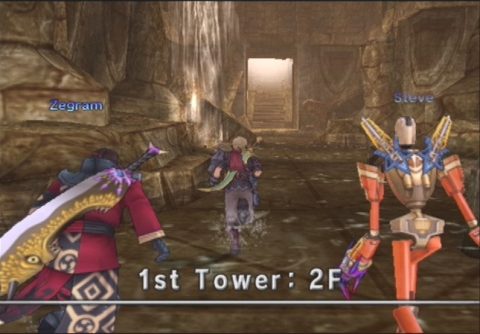 stronger than any of the bosses that you’ve encountered up to that point.
stronger than any of the bosses that you’ve encountered up to that point.
Not far into the game, you’ll meet up with a very strange creature; a giant toad. This toad has a special power that allows him to synthesize any two weapons you feed him so long as the weapons are of the same general type (i.e. you can’t fuse swords and spears) and both are maxed out. By feeding it two weapons, you’ll either receive an augmented version of one of the weapons you gave it, or a new type of weapon altogether. The stats of the weapon you end up with depend on how close to being mastered the two synthesized weapons were when you fed them to Toadie. The fusion process causes you to lose about 10% of the elemental stat bonuses you had on your weapons before you fused them, so if you just keep fusing weapons the instant they’re maxed out, you’re eventually going to end up with a really powerful weapon with completely base stat bonuses that are going to take a long time to rebuild. It saves time in the long run to properly “season” your weapons before you fuse them.
But that’s not all! A bit later, you’ll find yourself in possession of a run-down factory. By using a building/construction engine similar to the Georama system in Level-5’s own Dark Cloud, you can produce and invent items that you wont be able to find anywhere else. To do this, you’ll need ideas. Various NPCs throughout the galaxy have great ideas for items. You’ll need to track them down and turn their ideas into blueprints, and then reconstruct the factory in order to adequately utilize these blueprints, and lastly, you’ll need to provide the materials needed to create the item in question.
Lastly, and most exhausting, is the Insectron mini-game. Insectron is a whole separate game unto itself. You could easily chop it out of Rogue Galaxy, put it on a handheld system and sell it for retail price with hopes to compete with Pokémon, because in essence, that’s what Insectron is. Somewhat early in the game, you’re given the the opportunity to begin catching and raising Insectors, cute little bugs that you can raise and do battle with. By setting traps with bait, you can catch all kinds of Insectors which must be housed in a rearing cage. From the cage, you can raise your Insectron by feeding it or dueling it with other Insectrons in your cage. Each type of food you feed an Insectron effects its stats differently, increasing some while decreasing others. However, each piece of food you give it brings it closer to an inevitable brick wall where it will no longer be able to grow. At this point, you’ll have to breed it with another Insectron. Breeding a new Insectron will ultimately kill the parents, but the new Insectron will have a certain percentage of what the combined stats of the parents would be. Your new Insector, however, is an infant, and you’ll be able to raise it just as you did its parents, with each piece of food you feed it complimenting the combined stats of its parents. After several generations, you’ll have a fully evolved monster Insector that’ll cut swathes through anything that gets in its way.
Once you’ve raised a team of at least five Insectors, you’ll be able to compete in the Insectron Tournament, an epic, six-tiered contest, with each tier consisting of an endurance test of 5 consecutive matches with fellow Insector enthusiasts whom are obviously affectionate mockeries of Pokémon characters such as Ash. These battles are nothing like those in Pokémon, however. The layout is like a strategy RPG. You can move your Insectors about in a limited range on a chess-board like layout, and order them to attack once they’re in range. Each species of Insector has its own special attack, and it’s good to have a diverse team of Insectors so that you can exploit any weakness an enemy’s team may have. Winning the tournaments will net you all sorts of rewards.
Quite a bit of additional content was included exclusively in the North American release of Rogue Galaxy. One of these is an optional planet with its own little side story and set of monsters and bounties to hunt. The battle system also received a few refinements, most notably a new type of attack for each character called a “Burning Strike”. Burning Strikes are devastating counter moves performed while your character is blocking. Once the move is activated, a cinematic sequence begins with buttons popping up all over the screen. You’ll need to match these buttons with fairly well-timed presses in order to successfully execute the whole attack. If you’ve ever played the Legend of Dragoon, you’ll be familiar with Burning Strikes as they’re quite similar to Legend of Dragoon‘s Additions.
All of these elements add up to a game that provides a highly varied experience depending on how you play it. Most of the content can be ignored. You can survive well enough using store-bought weapons rather than utilizing the fusion system. The rewards from quarry hunting will not drastically change the flow of the game. The Insectron game can be ignored entirely if that’s not your thing. If you’re just looking to beat the game, you’ll be done after about 40 hours. But you’ll be seriously cheating yourself. The bonuses and rewards I’ve gotten for spending extra time with the game account for a great deal of the enjoyment and satisfaction I’ve had playing Rogue Galaxy. Exploring every nook and cranny and exhausting every facet of the game’s content will take you upwards of 150 hours, and easily more, but you’ll walk away with quite a few goodies, like the half a dozen or so alternate outfits for each character and insanely powerful weapons (which are required if you hope to take on the game’s post-endgame super dungeon and bosses therein). Replay value is also through the roof, as beating the game unlocks a whole new massive area to explore with its own story arcs.
Rogue Galaxy is huge, exciting and incredibly fun, and stands as one of the better action-RPGs on the PlayStation 2. And yet for all its greatness, it’s still very frustrating in that it could have been almost perfect had there been a better sense of balance established between the game’s story and the game itself. What you end up with is a lopsided title that provides you with more enjoyable, physical content than you can shake a stick at, but a narrative that wouldn’t impress a 12 year old. Depending on what this means to you, you’ll either love Rogue Galaxy and lose 100+ hours of your life without regret, or you’ll be entirely unimpressed with it. Therefore, I recommend Rogue Galaxy to JRPG fans tentatively. I can’t promise that you’ll like it, but I can promise that if you do, you’ll adore it.
